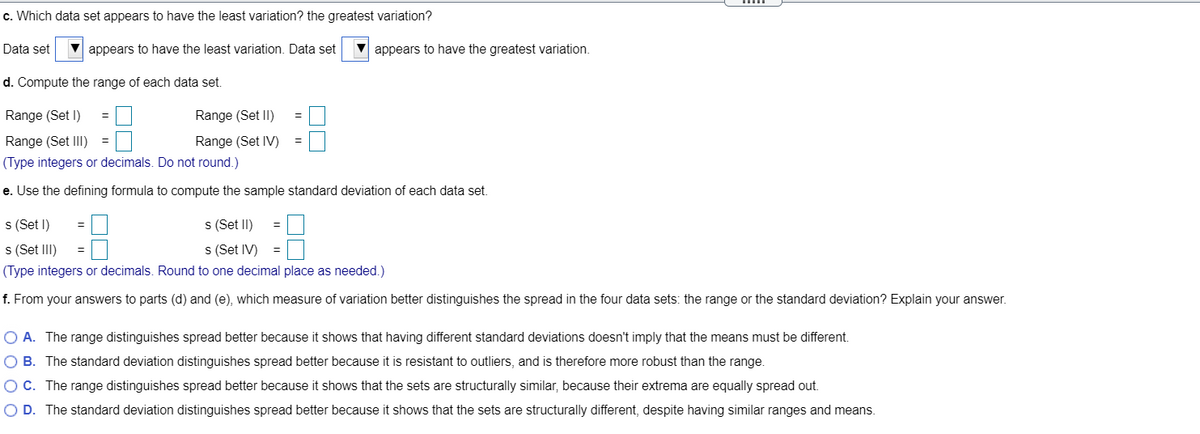Consider the following four data sets in the table below. Complete parts (a) through (g) below. E Click the icon to view the four data sets. Data sets .. a. Compute the mean of each data set. Data Set I Data Set II 9 x (Data Set I) x (Data Set II) = Data Set II Data Set IV 1 5 x (Data Set III) x (Data Set IV) 2 9 9 9 9 5 5 3 6 3 1 3 3 6 8 10 (Type integers or decimals. Do not round.) 3 9 1 4. 1 4 b. Although the four data sets have the same means, in what respect are they quite different? O A. Each data set has a unique median. O B. The amount of variation within each data set differs among the data sets. Print Done OC. The amount of variation within each data set is the same among the data sets, but with different values. O D. The data sets are not different as the four data sets are identical.
Consider the following four data sets in the table below. Complete parts (a) through (g) below. E Click the icon to view the four data sets. Data sets .. a. Compute the mean of each data set. Data Set I Data Set II 9 x (Data Set I) x (Data Set II) = Data Set II Data Set IV 1 5 x (Data Set III) x (Data Set IV) 2 9 9 9 9 5 5 3 6 3 1 3 3 6 8 10 (Type integers or decimals. Do not round.) 3 9 1 4. 1 4 b. Although the four data sets have the same means, in what respect are they quite different? O A. Each data set has a unique median. O B. The amount of variation within each data set differs among the data sets. Print Done OC. The amount of variation within each data set is the same among the data sets, but with different values. O D. The data sets are not different as the four data sets are identical.
Glencoe Algebra 1, Student Edition, 9780079039897, 0079039898, 2018
18th Edition
ISBN:9780079039897
Author:Carter
Publisher:Carter
Chapter10: Statistics
Section10.4: Distributions Of Data
Problem 19PFA
Related questions
Question
10) Solve all parts of the question correctly, please.

Transcribed Image Text:Consider the following four data sets in the table below. Complete parts (a) through (g) below.
Click the icon to view the four data sets.
Data sets
a. Compute the mean of each data set.
x (Data Set I)
x (Data Set II)
Data Set I
Data Set II
Data Set II
Data Set IV
%3D
=
1
1
9.
2
x (Data Set III)
x (Data Set IV)
2
6
1
9
3
6
8.
1
9
3
6.
(Type integers or decimals. Do not round.)
9.
1
9.
3
8
4
9.
1
10
b. Although the four data sets have the same means, in what respect are they quite different?
O A. Each data set has a unique median.
O B. The amount of variation within each data set differs among the data sets.
Print
Done
O C. The amount of variation within each data set is the same among the data sets, but with different values.
D. The data sets are not different as the four data sets are identical.

Transcribed Image Text:c. Which data set appears to have the least variation? the greatest variation?
Data set
V appears to have the least variation. Data set
V appears to have the greatest variation.
d. Compute the range of each data set.
Range (Set I)
Range (Set II)
Range (Set III)
Range (Set IV)
(Type integers or decimals. Do not round.)
e. Use the defining formula to compute the sample standard deviation of each data set.
s (Set I)
s (Set II)
%3D
s (Set III)
s (Set IV)
(Type integers or decimals. Round to one decimal place as needed.)
f. From your answers to parts (d) and (e), which measure of variation better distinguishes the spread in the four data sets: the range or the standard deviation? Explain your answer.
O A. The range distinguishes spread better because it shows that having different standard deviations doesn't imply that the means must be different.
O B. The standard deviation distinguishes spread better because it is resistant to outliers, and is therefore more robust than the range.
OC. The range distinguishes spread better because it shows that the sets are structurally similar, because their extrema are equally spread out.
O D. The standard deviation distinguishes spread better because it shows that the sets are structurally different, despite having similar ranges and means.
Expert Solution
This question has been solved!
Explore an expertly crafted, step-by-step solution for a thorough understanding of key concepts.
This is a popular solution!
Trending now
This is a popular solution!
Step by step
Solved in 6 steps with 3 images

Recommended textbooks for you

Glencoe Algebra 1, Student Edition, 9780079039897…
Algebra
ISBN:
9780079039897
Author:
Carter
Publisher:
McGraw Hill

Glencoe Algebra 1, Student Edition, 9780079039897…
Algebra
ISBN:
9780079039897
Author:
Carter
Publisher:
McGraw Hill